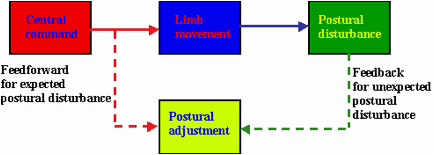State of the body consisting of the maintenance of relationships between body parts (body-referenced definition based on an egocentric coordinate system definition), relationships between body and environment (environmental-reference based on an exocentric coordinate system), and with reference to the gravitational vector or field (another environmental-referenced definition, but based on a geocentric coordinate system). Posture has three functions involving maintenance of: 1. stability in the face of gravity (i.e., an anti-gravity response); 2. stability in the face of externally-induced change (e.g., after a shoulder push when sitting or standing), which functions by means of feedback control; 3. stability in the face of self-induced change (e.g., when reaching for an object), which requires anticipation or feedforward control (see figure below).
